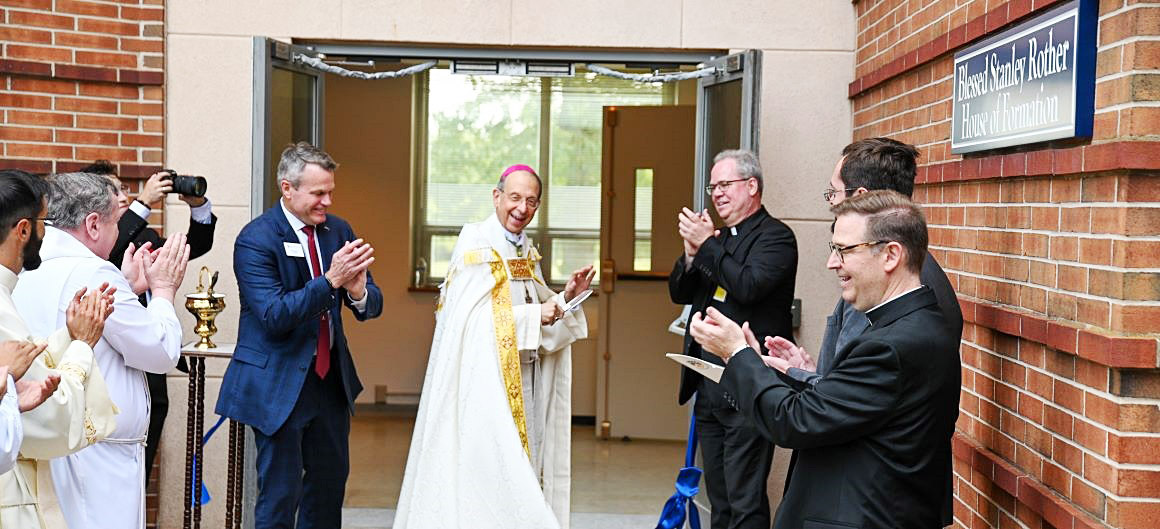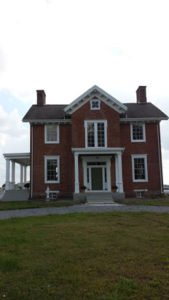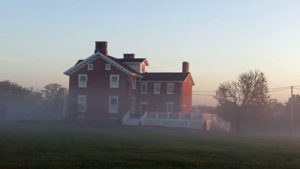First Seminarians Arrive
Richard D. L. Fulton
The Rother House, located within the Saint Joseph House on the Emmitsburg campus of the Daughters of Charity, was officially opened in late-August as an extension of Mount Saint Mary’s seminary.
The Rother House is located in the C-wing of the Saint Joseph House. The Saint Joseph House was originally built in 1964 to serve as the home to hundreds of Daughters of Charity.
The Daughters generously leased this space to the seminary. Many of the Daughters received their initial phase in their religious life in the C-wing.
The new facility will be employed in housing seminarians who will be serving their initial year of their induction into the priesthood, also known as the “propaedeutic stage.”
According to the Reverend Daniel Hanely, coordinator of the seminary’s Propaedeutic Stage Program, “The propaedeutic stage is an initial year that all U.S. seminarians will complete, one focused less on academics, more on growing in community and service, and cultivating virtue and a deep prayer life.”
Hanely further noted that the propaedeutic stage “lays a strong foundation for the more intense academics and formation in seminary.”
Regarding the Daughters of Charity’s offer to permit the Seminary to establish the Rother House in the Saint Joseph House, Monsignor Andrew Baker stated, “We continue the legacy of the Daughters of Charity, their love for formation and education, and look into the future of the Church as we prepare these seminarians for further priestly formation. We could not have established Rother House without the support of the Daughters of Charity, to whom we are deeply indebted.”
Donna Klinger, Mount Saint Mary’s University’s (MSMU) executive director of communications, reported that the seminary held a ribbon-cutting and dedication ceremony on August 22, in which Archbishop of Baltimore William E. Lori blessed every room in the building with Holy Water. The event, appropriately held on the Feast of the Queenship of Mary, included Mass in the Rother House’s Mary, Mother of the Fairest Love Chapel.
Archbishop Lori, who served as celebrant for the Mass and is chair of the Seminary Board, stated that a (propaedeutic stage) program being inaugurated on the Feast of the Queenship of Mary, named for Blessed Stanley Rother and located at the former home of Saint Elizabeth Ann Seton, is certain to succeed.” Other concelebrants included Bishop of Richmond Barry C. Knestout, Monsignor Baker, Father Daniel Hanley, and Monsignor Charles Mangan, Rother House confessor.
Klinger stated that 29 men who have been called to seminary have moved into the Blessed Stanley Rother House of Formation, also known as the Rother House, for the new propaedeutic stage of priestly formation at Mount St. Mary’s Seminary.
“We’re just so grateful for the immense support Monsignor Andrew Baker, the Mount community, and the Daughters of Charity have shown,” exclaimed Hanley, adding, “We’re thrilled to welcome young men to Rother House.”
Klinger noted that Hanley is “particularly qualified to oversee the creation of Rother House. Before joining Mount St. Mary’s Seminary in January, he worked for the USCCB (United States Conference of Catholic Bishops), helping put together the latest edition of the ‘Program for Priestly Formation.’ As coordinator, he is in charge of mapping out the course of the propaedeutic stage for Mount St. Mary’s Seminary.”
A typical day starts early with quiet meditation, morning prayer, Mass, and breakfast. Midmorning, a few simple classes are held, mostly focused on spirituality, the Catechism of the Catholic Church, and scripture. Lunch and dinner are eaten together, with afternoons spent in service to the wider community.
“We’ll have partnerships with a few local places, such as the National Shrine Grotto and a farm, and the seminarians in Rother House will do their own cleaning. Adoration will come before dinner, and then recreation until night prayer,” Hanley noted. The farmwork will be done at Good Soil Farm, owned by Stephen and Casey-Mae McGinley, both graduates of the Mount. Stephen McGinley is also a lecturer of philosophy.
Seminarians in Rother House are expected to mostly forego the use of phones, televisions, and computers, and spend their days getting to know each other, themselves, and God better, getting the chance to further discern their calling before the later rigors of seminary.

Clerical attendees at Rother House ribbon-cutting.



